Spin-Peierls, Spin-Ladder and Kondo Coupling in Weakly Localized Quasi-1D Molecular Systems: An Overview
Abstract
1. Basic Interactions in Quasi-1D Molecular Systems
2. Half-Filled (ρ = 1) Versus Quarter-Filled (ρ = 1/2) Organic Systems
3. Antiferromagnetic Coupling in Spin-1/2 Weakly Localized Organic Stacks
4. Spin-Peierls Fluctuations on Donor Stacks in D2X Weakly Localized Conductors
5. Kondo Coupling between Localized and Delocalized Stacks in the Per2-M(mnt)2 Series
6. Spin-Ladder Behavior in the (DT-TTF)2M(mnt)2 Series
7. Coexistence of 4kF BOW and 4kF CDW Orders in Quarter-Filled Systems
8. Soliton Nucleation in Perturbed Spin-Peierls Compounds
9. Concluding Remarks
Funding
Institutional Review Board Statement
Informed Consent Statement
Data Availability Statement
Acknowledgments
Conflicts of Interest
Annex: Chemical Names of Organic Molecules Quoted in the Main Text
| Per | perylene |
| (CH)x | polyacetylene |
| TCNQ | tetracyanoquinodimethane |
| Qn | quinolinium |
| NMP | N-methylphenazinium |
| MEM | N-methyl-N-ethylmorpholinium |
| TTF | tetrathiafulvalene |
| DIMET | dimethyl-ethylene-tetrathiafulvalene |
| t-TTF | trimethylene-tetrathiafulvalene |
| TMTTF | tetramethyl-tetrathiafulvalene |
| TMTSF | tetramethyl-tetraselenafulvalene |
| BCP-TTF | benzo-cyclopentyl-tetrathiafulvalene |
| o-DMTTF | ortho-dimethyl-tetrathiafuvalene |
| DTTTF | dithiophen-tetrathiafulvalene |
| mnt | maleonotril-dithiolate |
References
- Alcácer, L. The Physics of Organic Electronics: From Molecules to Crystals and Polymers; IOP Publishing: Bristol, UK, 2022. [Google Scholar]
- Pouget, J.-P. The Peierls instability and charge density wave in one-dimensional electronic conductors. Comptes Rendus Phys. 2016, 17, 332–356. [Google Scholar] [CrossRef]
- Hubbard, J. Generalized Wigner lattices in one dimension and some applications to tetracyanoquinodimethane (TCNQ) salts. Phys. Rev. B 1978, 17, 494–505. [Google Scholar] [CrossRef]
- Pouget, J.-P. Bond and charge ordering in low-dimensional organic conductors. Phys. B Condens. Matter. 2012, 407, 1762–1770. [Google Scholar] [CrossRef]
- Nakamura, M. Mechanism of CDW-SDW Transition in One Dimension. J. Phys. Soc. Jpn. 1999, 68, 3123–3126. [Google Scholar] [CrossRef]
- Tsuchiizu, M.; Furusaki, A. Ground-state phase diagram of the one-dimensional half-filled extended Hubbard model. Phys. Rev. B 2004, 69, 035103. [Google Scholar] [CrossRef]
- Emery, V.J.; Noguera, C. Critical Properties of a Spin-1/2 Chain with Competing Interactions. Phys. Rev. Lett. 1988, 60, 631–634. [Google Scholar] [CrossRef]
- Mila, F.; Zotos, X. Phase Diagram of the One-Dimensional Extended Hubbard Model at Quarter-Filling. Europhys. Lett. 1993, 24, 133–138. [Google Scholar] [CrossRef]
- Schmitteckert, P.; Werner, R. Charge-density-wave instabilities driven by multiple umklapp scattering. Phys. Rev. B 2004, 69, 195115. [Google Scholar] [CrossRef]
- Bakrim, H.; Bourbonnais, C. Nature of ground states in one-dimensional electron-phonon Hubbard models at half filling. Phys. Rev. B 2015, 91, 085114. [Google Scholar] [CrossRef]
- Clay, R.T.; Mazumdar, S.; Campbell, D.K. Pattern of charge ordering in quasi-one-dimensional organic charge-transfer solids. Phys. Rev. B 2003, 67, 115121. [Google Scholar] [CrossRef]
- Emery, V.J.; Bruinsma, R.; Barišić, S. Electron-Electron Umklapp Scattering in Organic Superconductors Phys. Rev. Lett. 1982, 48, 1039–1043. [Google Scholar] [CrossRef]
- Giamarchi, T. Theoretical Framework for Quasi-One-Dimensional Systems. Chem. Rev. 2004, 104, 5037–5055. [Google Scholar] [CrossRef]
- Penc, K.; Mila, F. Charge gap in the one-dimensional dimerized Hubbard model at quarter-filling. Phys. Rev. B 1994, 50, 11429–11445. [Google Scholar] [CrossRef] [PubMed]
- Pouget, J.-P.; Ravy, S. Structural Aspects of the Bechgaard Salts and Related Compounds. J. Phys. I Fr. 1996, 6, 1501–1525. [Google Scholar] [CrossRef]
- Pouget, J.-P.; Alemany, P.; Canadell, E. Donor–anion interactions in quarter-filled low-dimensional organic conductors. Mater. Horiz. 2018, 5, 590–640. [Google Scholar] [CrossRef]
- Eggert, S.; Affleck, I.; Takahash, M. Susceptibility of the Spin 1/2 Heisenberg Antiferromagnetic Chain. Phys. Rev. Lett. 1994, 73, 332–335. [Google Scholar] [CrossRef] [PubMed]
- Liu, Q.; Ravy, S.; Pouget, J.P.; Coulon, C.; Bourbonnais, C. Structural fluctuations and spin-Peierls transitions revisited. Synth. Met. 1993, 56, 1840–1845. [Google Scholar] [CrossRef]
- Foury-Leylekian, P.; Petit, S.; Coulon, C.; Hennion, B.; Moradpour, A.; Pouget, J.P. Inelastic neutron scattering investigation of magnetic excitations in the spin-Peierls ground state of (TMTTF)2PF6. Phys. B Condens. Matter 2009, 404, 537–540. [Google Scholar] [CrossRef]
- Dumm, M.; Loidl, A.; Fravel, B.W.; Starkey, K.P.; Montgomery, L.K.; Dressel, M. Electron spin resonance studies on the organic linear-chain compounds (TMTCF)2X (C = S, Se; X = PF6, AsF6, ClO4, Br). Phys. Rev. B 2000, 61, 511–521. [Google Scholar] [CrossRef]
- Soriano, L.; Pilone, O.; Kuz’Min, M.D.; Vezin, V.; Jeannin, O.; Fourmigué, M.; Orio, M.; Bertaina, S. Electron-spin interaction in the spin-Peierls phase of the organic spin chain (o-DMTTF)2X (X = Cl, Br, I). Phys. Rev. B 2022, 105, 064434. [Google Scholar] [CrossRef]
- Jeannin, O.; Reinheimer, E.W.; Foury-Leylekian, P.; Pouget, J.P.; Auban-Senzier, P.; Trzop, E.; Collet, E.; Fourmigué, M. Decoupling anion-ordering and spin-Peierls transitions in a strongly one-dimensional organic conductor with a chessboard structure, (o-Me2TTF)2NO3. IUCrJ 2018, 5, 361–372. [Google Scholar] [CrossRef] [PubMed]
- Fuseya, Y.; Tsuchiizu, M.; Suzumura, Y.; Bourbonnais, C. Role of Interchain Hopping in the Magnetic Susceptibility of Quasi-One-Dimensional Electron Systems. J. Phys. Soc. Jpn. 2007, 76, 014709. [Google Scholar] [CrossRef]
- Cano-Cortés, L.; Dolfen, A.; Merino, J.; Behler, J.; Delley, B.; Reuter, K.; Koch, E. Coulomb parameters and photoemission for the molecular metal TTF-TCNQ. Eur. Phys. J. B 2007, 56, 173–176. [Google Scholar] [CrossRef]
- Pouget, J.P.; Foury-Leylekian, P.; Almeida, M. Peierls and Spin-Peierls Instabilities in the Per2[M(mnt)2] Series of One-Dimensional Organic Conductors; Experimental Realization of a 1D Kondo Lattice for M = Pd, Ni and Pt. Magnetochemistry 2017, 3, 13. [Google Scholar] [CrossRef]
- Dumoulin, B.; Bourbonnais, C.; Ravy, S.; Pouget, J.P.; Coulon, C. Fluctuation effects in low-dimensional spin-Peierls systems: Theory and experiment. Phys. Rev. Lett. 1996, 76, 1360–1363. [Google Scholar] [CrossRef]
- Pouget, J.P. Microscopic interactions in CuGeO3 and organic Spin-Peierls systems deduced from their pretransitional lattice fluctuations. Eur. Phys. J. B 2001, 20, 321–333, Erratum in Eur. Phys. J. B 2001, 24, 415. [Google Scholar] [CrossRef]
- Caron, L.G.; Moukouri, S. Density Matrix Renormalization Group Applied to the Ground State of the XY Spin-Peierls System. Phys. Rev. Lett. 1996, 76, 4050–5053. [Google Scholar] [CrossRef]
- Citro, R.; Orignac, E.; Giamarchi, T. Adiabatic-antiadiabatic crossover in a spin-Peierls chain. Phys. Rev. B 2005, 72, 024434. [Google Scholar] [CrossRef]
- Uhrig, G.S. Nonadiabatic Approach to Spin-Peierls Transitions via Flow Equations. Phys. Rev. B 1998, 57, R14004. [Google Scholar] [CrossRef]
- Liu, Q.; Ravy, S.; Moret, R.; Pouget, J.P.; Coulon, C.; Bechgaard, K. Structural investigation of new 2:1 series of organic conductors. Synth. Met. 1991, 42, 1879–1883. [Google Scholar] [CrossRef]
- Pouget, J.P.; Foury-Leylekian, P.; Petit, S.; Hennion, B.; Coulon, C.; Bourbonnais, C. Inelastic neutron scattering investigation of magnetostructural excitations in the spin-Peierls organic system (TMTTF)2PF6. Phys. Rev. B 2017, 96, 035127. [Google Scholar] [CrossRef]
- Almeida, M.; Henriques, R.T. Perylene Based Conductors. Chapter 2. In Handbook of Organic Conductive Molecules and Polymers Volume 1 “Charge Transfer Salts, Fullerenes and Photoconductors”; Nalva, H.S., Ed.; John Wiley & Sons Ltd.: Chichester, UK, 1997; pp. 87–149. [Google Scholar]
- Alcacer, L.; Maki, A.H. Magnetic Properties of Some Electrically Conducting Perylene-Metal Dithiolate Complexes. J. Phys. Chem. 1976, 80, 1912–1916. [Google Scholar] [CrossRef]
- Bourbonnais, C.; Henriques, R.T.; Wzietek, P.; Kongeter, D.; Voiron, J.; Jérom, D. Nuclear and electronic resonance approaches to magnetic and lattice fluctuations in the two-chain family of organic compounds (perylene2 [M(S2C2(CN)2)2] (M = Pt, Au). Phys. Rev. B 1991, 44, 641–651. [Google Scholar] [CrossRef] [PubMed]
- Gama, V.; Henriques, R.T.; Bonfait, G.; Almeida, M.; Ravy, S.; Pouget, J.P.; Alcacer, L. The interplay between conduction electrons and chains of localized spins in the molecular metals (Per)2M(mnt)2, M = Au, Pt, Pd, Ni, Cu, Co and Fe. Mol. Cryst. Liq. Cryst. 1993, 234, 171–178. [Google Scholar] [CrossRef]
- Henriques, R.T.; Alcacer, L.; Pouget, J.P.; Jérome, D. Electrical conductivity and X-ray diffuse scattering study of the family of organic conductors (perylene)2M(mnt)2, (M = Pt, Pd, Au). J. Phys. C Solid State Phys. 1984, 17, 5197–5208. [Google Scholar] [CrossRef]
- Dagotto, E.; Rice, T.M. Surprises on the way from one-to two-dimensional quantum magnets: The ladder materials. Science 1996, 271, 618–623. [Google Scholar] [CrossRef]
- Rovira, C.; Veciana, J.; Ribera, E.; Tarrks, J.; Canadell, E.; Rousseau, R.; Mas, M.; Molins, E.; Almeida, M.; Henriques, R.T.; et al. An Organic Spin-Ladder Molecular Material. Angew. Chem. Int. Ed. Engl. 1997, 36, 2323–2326. [Google Scholar] [CrossRef]
- Silva, R.A.L.; Almeida, M. Spin-ladder behaviour in molecular materials. J. Mater. Chem. C 2021, 9, 10573–10590. [Google Scholar] [CrossRef]
- Dias, J.C.; Lopes, E.B.; Santos, I.C.; Duarte, M.T.; Henriques, R.T.; Almeida, M.; Ribas, X.; Rovira, C.; Veciana, J.; Foury-Leylekian, P.; et al. Structural and Electrical Properties of (DT-TTF)2[Cu(mnt)2]. J. Phys. IV Fr. 2004, 114, 497–499. [Google Scholar] [CrossRef]
- Ribas, X.; Mas-Torrent, M.; Pérez-Benítez, A.; Dias, J.C.; Alves, H.; Lopes, E.B.; Henriques, R.T.; Molins, E.; Santos, I.C.; Wurst, K.; et al. Organic Spin-Ladder from Tetrathiafulvalene (TTF) Derivatives. Adv. Funct. Mater. 2005, 15, 1023–1035. [Google Scholar] [CrossRef]
- Silva, R.A.L.; Santos, I.C.; Wright, J.; Coutinho, J.T.; Pereira, L.C.J.; Lopes, E.B.; Rabaça, S.; Vidal-Gancedo, J.; Rovira, C.; Almeida, M.; et al. Dithiophene-TTF Salts; New Ladder Structures and Spin-Ladder Behavior. Inorg. Chem. 2015, 54, 7000–7006. [Google Scholar] [CrossRef] [PubMed]
- Musfeldt, J.L.; Brown, S.; Mazumdar, S.; Clay, R.T.; Mas-Torrent, M.; Rovira, C.; Dias, J.C.; Henriques, R.T.; Almeida, M. Infrared investigation of the charge ordering pattern in the organic spin ladder candidate (DTTTF)2Cu(mnt)2. Solid State Sci. 2008, 10, 1740–1744. [Google Scholar] [CrossRef]
- Wesołowski, R.; Haraldsen, J.T.; Musfeldt, J.L.; Barnes, T.; Mas-Torrent, M.; Rovira, C.; Henriques, R.T.; Almeida, M. Infrared investigation of the low-temperature structural and magnetic transitions in the spin-ladder candidate (DT-TTF)2Au(mnt)2. Phys. Rev. B 2003, 68, 134405. [Google Scholar] [CrossRef]
- Ribera, E.; Rovira, C.; Veciana, J.; Tarés, J.; Canadell, E.; Rousseau, R.; Molins, E.; Mas, M.; Schoeffel, J.P.; Pouget, J.-P.; et al. The [(DT-TTF)2M(mnt)2] Family of Radical Ion Salts: From a Spin Ladder to Delocalised Conduction Electrons That Interact with Localised Magnetic Moments. Chem. Eur. J. 1999, 5, 2025–2039. [Google Scholar] [CrossRef]
- Clay, R.T.; Mazumdar, S. Cooperative DensityWave and Giant Spin Gap in the Quarter-Filled Zigzag Electron Ladder. Phys. Rev. Lett. 2005, 94, 207206. [Google Scholar] [CrossRef] [PubMed]
- Ribera, E.; Rovira, C.; Veciana, J.; Tarés, J.; Canadell, E.; Rousseau, R.; Molins, E.; Mas, M.; Schoeffel, J.P.; Pouget, J.-P.; et al. The (DT-TTF)-M(mnt)2 Family of Compounds. Synth. Met. 1999, 102, 1743–1746. [Google Scholar] [CrossRef]
- Monceau, P.; Nad, F.Y.; Brazovskii, S. Ferroelectric Mott-Hubbard Phase of Organic (TMTTF)2X Conductors. Phys. Rev. Lett. 2001, 86, 4080–4083. [Google Scholar] [CrossRef]
- de Souza, M.; Squillante, L.; Sônego, C.; Menegasso, P.; Foury-Leylekian, P.; Pouget, J.P. Probing the ionic dielectric constant contribution in the ferroelectric phase of the Fabre salts. Phys. Rev. B 2018, 97, 045122. [Google Scholar] [CrossRef]
- Dressel, M.; Dumm, M.; Knoblauch, T.; Masino, M. Comprehensive Optical Investigations of Charge Order in Organic Chain Compounds (TMTTF)2X. Crystals 2012, 2, 528–578. [Google Scholar] [CrossRef]
- Kitou, S.; Fujii, T.; Kawamoto, T.; Katayama, N.; Maki, S.; Nishibori, E.; Sugimoto, K.; Takata, M.; Nakamura, T.; Sawa, H. Successive Dimensional Transition in (TMTTF)2PF6 Revealed by Synchrotron X-ray Diffraction. Phys. Rev. Lett. 2017, 119, 065701. [Google Scholar] [CrossRef]
- Foury-Leylekian, P.; Petit, S.; Andre, G.; Moradpour, A.; Pouget, J.-P. Neutron scattering evidence for a lattice displacement at the charge ordering transition of (TMTTF)2PF6. Phys. B Condens. Matter 2010, 405, S95–S97. [Google Scholar] [CrossRef]
- de Souza, M.; Foury-Leylekian, P.; Moradpour, A.; Pouget, J.-P.; Lang, M. Evidence for Lattice Effects at the Charge-Ordering Transition in (TMTTF)2X. Phys. Rev. Lett. 2008, 101, 216403. [Google Scholar] [CrossRef]
- de Souza, M.; Pouget, J.P. Charge-ordering transition in (TMTTF)2X explored via dilatometry. J. Phys. Condens. Matter 2013, 25, 343201. [Google Scholar] [CrossRef]
- Yasin, S.; Salameh, B.; Rose, E.; Dumm, M.; von Nidda, H.A.K.; Loidl, A.; Ozerov, M.; Untereiner, G.; Montgomery, L.; Dressel, M. Broken magnetic symmetry due to charge-order ferroelectricity discovered in (TMTTF)2X salts by multifrequency ESR. Phys. Rev. B 2012, 85, 144428. [Google Scholar] [CrossRef]
- Dutoit, C.-E.; Bertaina, S.; Orio, M.; Dressel, M.; Stepanov, A. Charge-ordering induces magnetic axes rotation in organic materials (TMTTF)2X (with X = SbF6, AsF6, and PF6). Low Temp. Phys. 2015, 41, 942–944. [Google Scholar] [CrossRef]
- Dutoit, C.E.; Stepanov, A.; van Tol, J.; Orio, M.; Bertaina, S. Superlattice Induced by Charge order in the organic Spin Chain (TMTTF)2X (X = SbF6, AsF6, and PF6) Revealed by High-Field Electron Paramagnetic Resonance. J. Phys. Chem. Lett. 2018, 9, 5598–5603. [Google Scholar] [CrossRef] [PubMed]
- Tennant, D.A.; Perring, T.G.; Cowley, R.A.; Nagle, S.E. Unbound spinons in the S = 1/2 antiferromagnetic chain KCuF3. Phys. Rev. Lett. 1993, 70, 4003–4006. [Google Scholar] [CrossRef]
- Arai, M.; Fujita, M.; Motokawa, M.; Akimitsu, J.; Bennington, S.M. Quantum Spin Excitations in the Spin-Peierls System CuGeO3. Phys. Rev. Lett. 1996, 77, 3647–3652. [Google Scholar] [CrossRef]
- Bertaina, S.; Dutoit, C.-E.; Van Tol, J.; Dressel, M.; Barbara, B.; Stepanov, A. Rabi oscillations of pinned solitons in spin chains: A route to quantum computation and communication. Phys. Rev. B 2014, 90, 060404(R). [Google Scholar] [CrossRef]
- Zeisner, J.; Pilone, O.; Soriano, L.; Gerbaud, G.; Vezin, H.; Jeannin, O.; Fourmigué, M.; Büchner, B.; Kataev, V.; Bertaina, S. Coherent spin dynamics of solitons in the organic spin chain compounds (o-DMTTF)2X (X = Cl, Br). Phys. Rev. B 2019, 100, 224414. [Google Scholar] [CrossRef]
- Coulon, C.; Lalet, G.; Pouget, J.-P.; Foury-Leylekian, P.; Moradpour, A.; Fabre, J.-M. Anisotropic conductivity and charge ordering in (TMTTF)2X salts probed by ESR. Phys. Rev. B 2007, 76, 085126. [Google Scholar] [CrossRef]
- Coulon, C.; Foury-Leylekian, P.; Fabre, J.-M.; Pouget, J.-P. Electronic instabilities and Irradiation effects in the (TMTTF)2X series. Eur. Phys. J. B 2015, 88, 85. [Google Scholar] [CrossRef]
- Soriano, L.; Zeisner, J.; Kataev, V.; Pilone, O.; Fourmigué, M.; Jeannin, O.; Vezin, H.; Orio, M.; Bertaina, S. Electron Spin Resonance of Defects in Spin Chains o-(DMTTF)2X: A versatile system behaving like molecular magnet. Appl. Mag. Res. 2020, 51, 1307–1320. [Google Scholar] [CrossRef]
- Soriano, L.; Orio, M.; Pilone, O.; Jeannin, O.; Reinheimer, E.; Quéméré, N.; Auban-Senzier, P.; Fourmigué, M.; Bertaina, S. A tetrathiafulvalene salt of the nitrite (NO2−) anion: Investigations of the spin-Peierls phase. J. Mater. Chem. C 2023. [Google Scholar] [CrossRef]
- Gama, V.; Henriques, R.T.; Almeida, M.; Pouget, J.P. Diffuse X-ray Scattering Evidence for Peierls and “Spin Peierls” Like Transitions in the Organic Conductors (Perylene)2 [M(mnt)2] (M = Cu, Ni, Co and Fe). Synth. Met. 1993, 56, 1677–1682. [Google Scholar] [CrossRef]
- Green, E.L.; Lumata, L.L.; Brooks, J.S.; Kuhns, P.; Reyes, A.; Brown, S.E.; Almeida, M. 1H and 195Pt NMR Study of the Two-Chain Compound Per2[Pt(mnt)2]. Crystals 2012, 2, 1116–1135. [Google Scholar] [CrossRef]
- Pouget, J.P.; Ravy, S.; Schoeffel, J.P.; Dhalenne, G.; Revcolevschi, A. Spin-Peierls lattice fluctuations and disorders in CuGeO3 and its solid solutions. Eur. Phys. J. B 2004, 38, 581–598. [Google Scholar] [CrossRef]
- Bertaina, S.; Dutoit, C.E.; Van Tol, J.; Dressel, M.; Barbara, B.; Stepanov, A. Quantum coherence of strongly correlated defects in spin chains. Phys. Procedia 2015, 75, 23–28. [Google Scholar] [CrossRef]
- Gotschy, B.; Auban-Senzier, P.; Farrall, A.; Bourbonnais, C.; Jérome, D.; Canadell, E.; Henriques, R.T.; Johannsen, I.; Bechgaard, K. One-dimensional physics in organic conductors (TMDTDSF)2X, X = PF6, ReO4: 77Se-NMR experiments. J. Phys. I 1992, 2, 677–694. [Google Scholar] [CrossRef]
- Liu, Q.; Ravy, S.; Pouget, J.P.; Johannsen, I.; Bechgaard, K. X-Ray Investigation of the Tetramethyldithiadiselenafulvalene (TMDTDSF)2X Series of Organic Conductors: II. Influence of the Orientational Disorder on the Structural Instabilities. J. Phys. I Fr. 1993, 3, 821–837. [Google Scholar]
- Grenier, B.; Renard, J.P.; Veillet, P.; Paulsen, C.; Dhalenne, G.; Revcolevschi, A. Scaling in dimer breaking by impurities in CuGeO3: A comparative experimental study of Zn-, Mg-, Ni-, and Si-doped single crystals. Phys. Rev. B 1998, 58, 8202. [Google Scholar] [CrossRef]
- Zeman, J.; Martinez, G.; van Loosdrecht, P.H.M.; Dhalenne, G.; Revcolevschi, A. Scaling of the H-T Phase Diagram of CuGeO3. Phys. Rev. Lett. 1999, 83, 2648–2651. [Google Scholar] [CrossRef]
- Brown, S.E.; Clark, W.G.; Zamborszky, F.; Klemme, B.J.; Kriza, G.; Alavi, B.; Merlic, C.; Kuhns, P.; Moulton, W. 13C NMR Measurements of the High-Magnetic-Field, Low-Temperature Phases of (TMTTF)2PF6. Phys. Rev. Lett. 1998, 80, 5429–5432. [Google Scholar] [CrossRef]
- Horvatíc, M.; Fagot-Revurat, Y.; Berthier, C.; Dhalenne, G.; Revcolevschi, A. NMR Imaging of the Soliton Lattice Profile in the Spin-Peierls Compound CuGeO3. Phys. Rev. Lett. 1999, 83, 420–423. [Google Scholar] [CrossRef]
- Rønnow, H.M.; Enderle, M.; McMorrow, D.F.; Regnault, L.-P.; Dhalenne, G.; Revcolevschi, A.; Hoser, A.; Prokes, K.; Vorderwisch, P.; Schneider, H. Neutron Scattering Study of the Field-Induced Soliton Lattice in CuGeO3. Phys. Rev. Lett. 2000, 84, 4469–4472. [Google Scholar] [CrossRef] [PubMed]

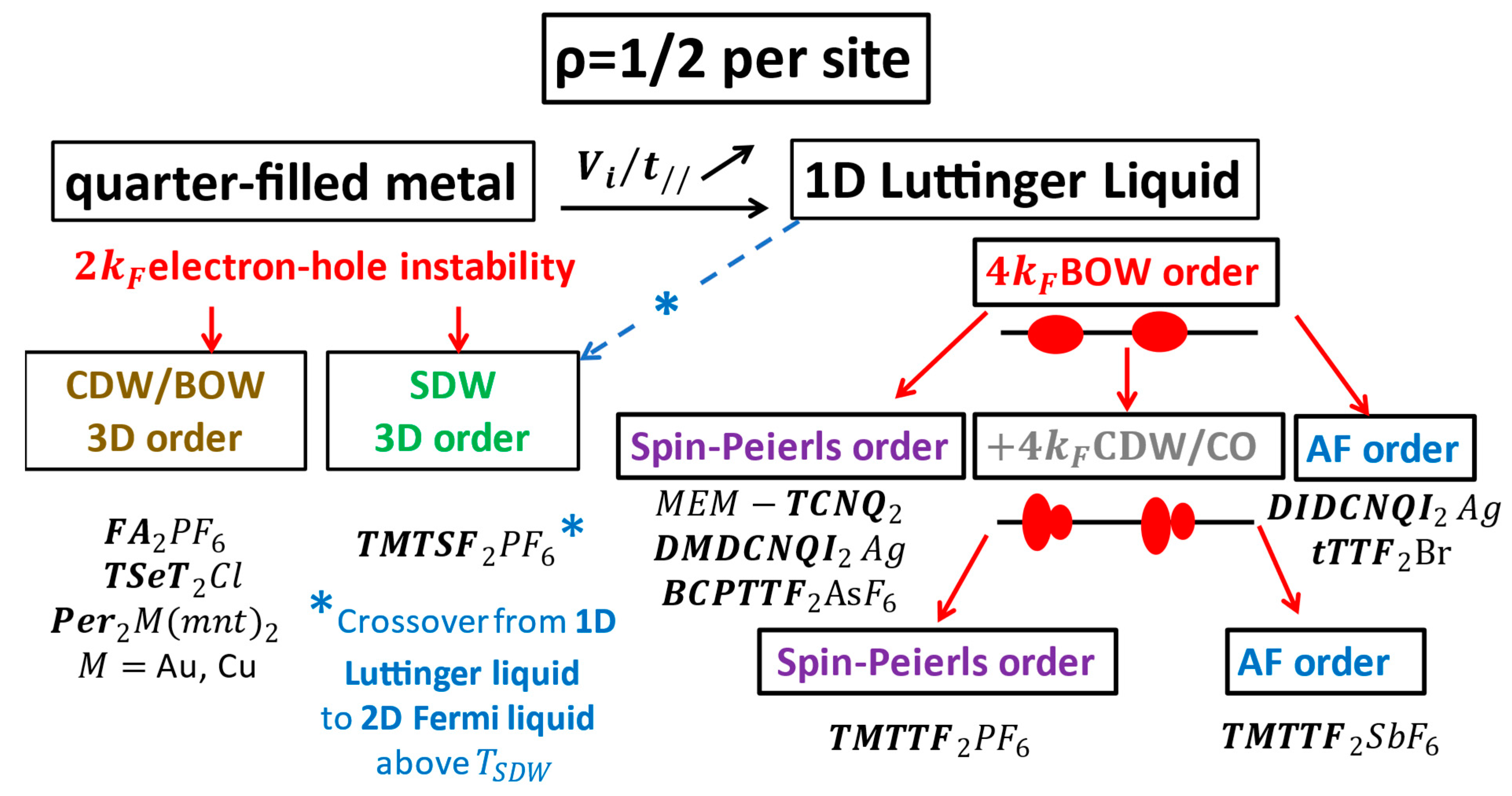


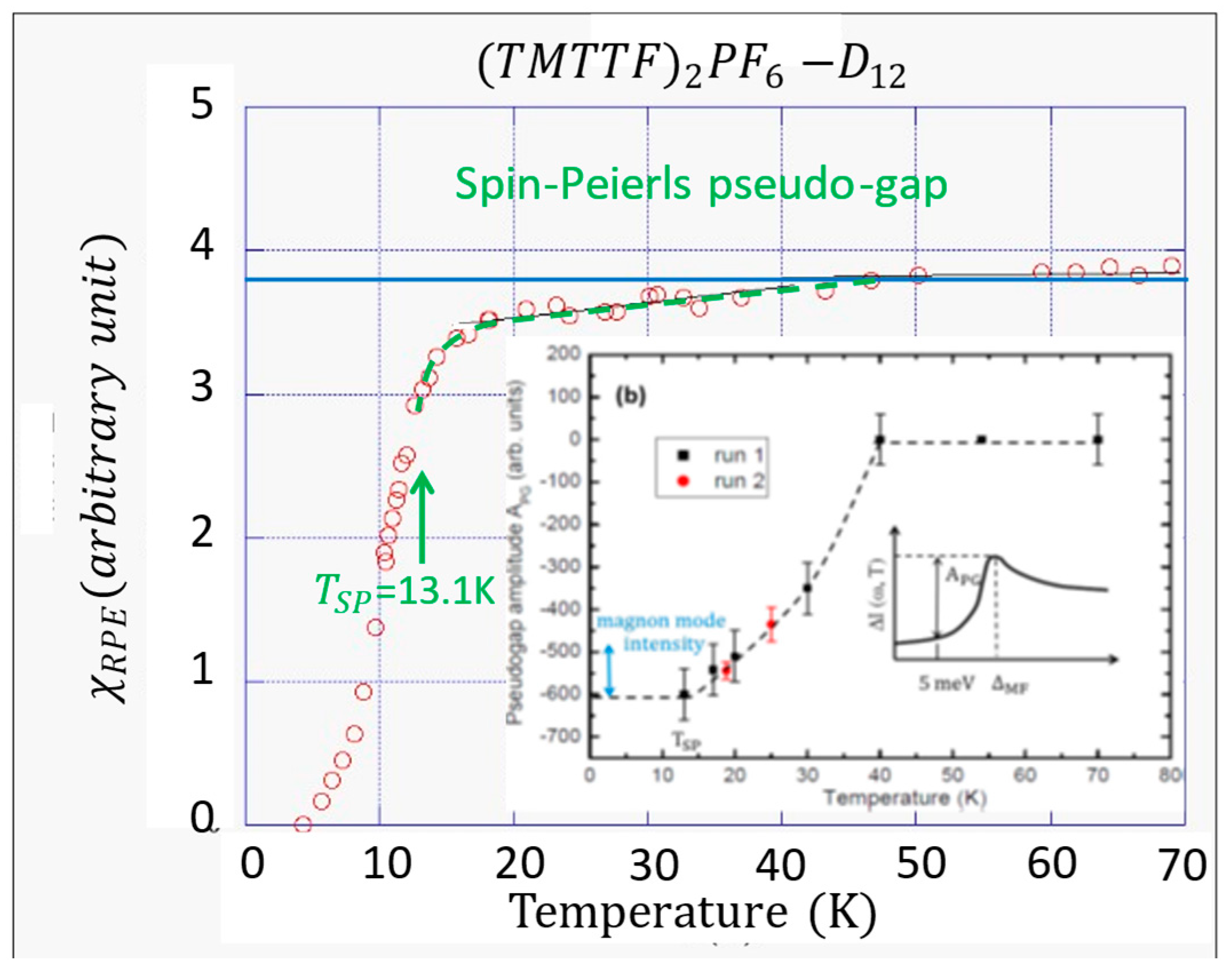
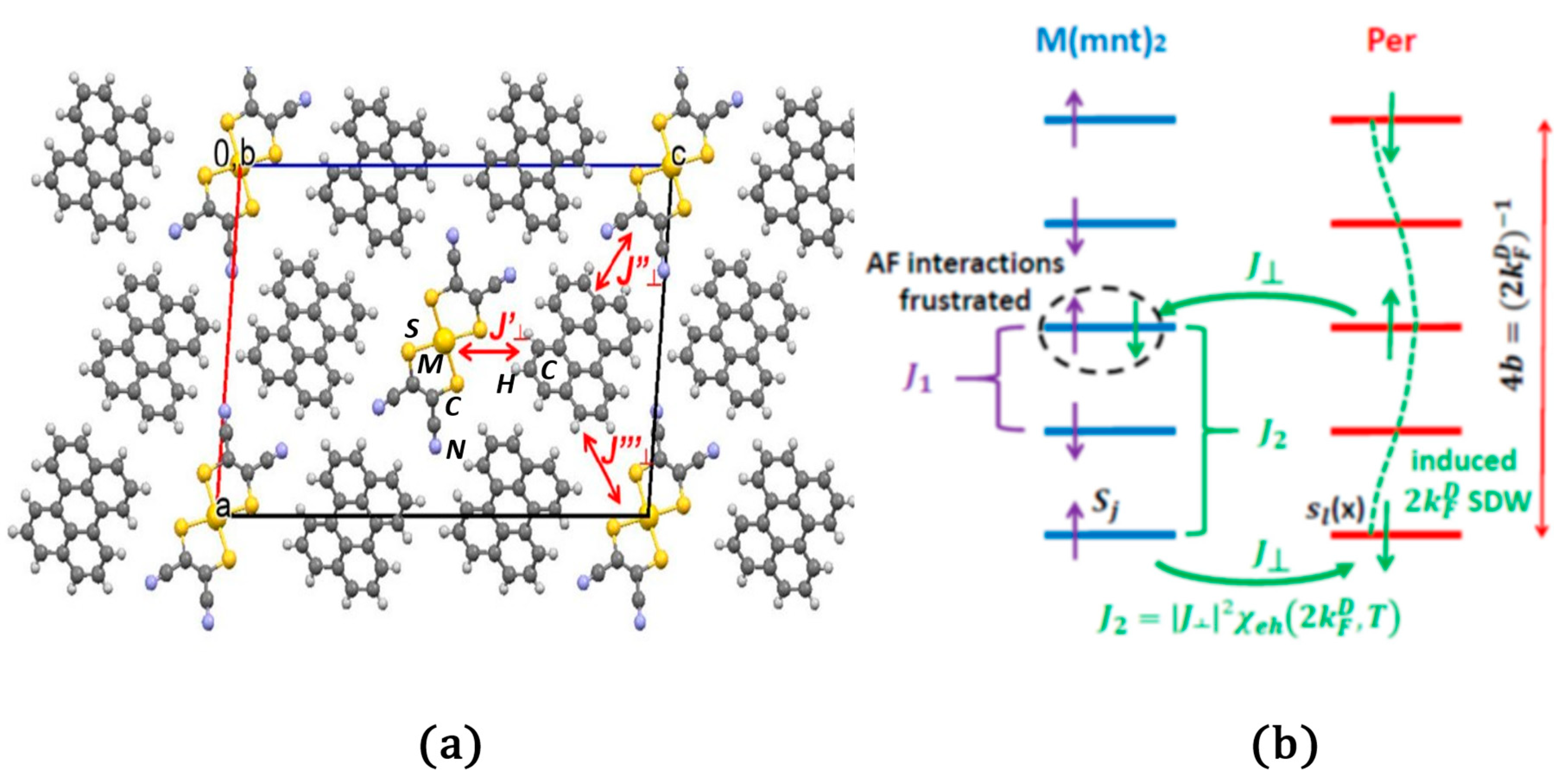
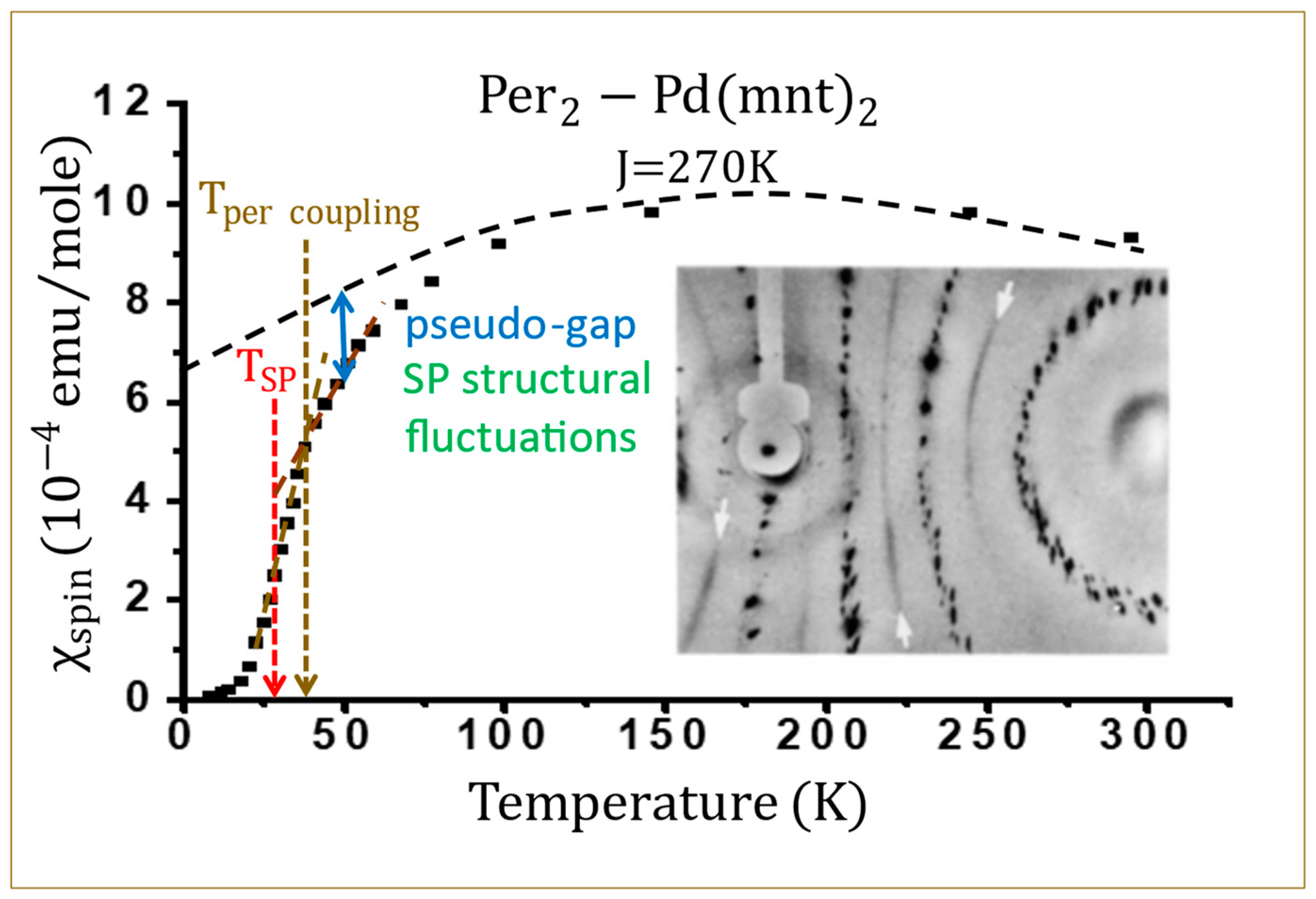
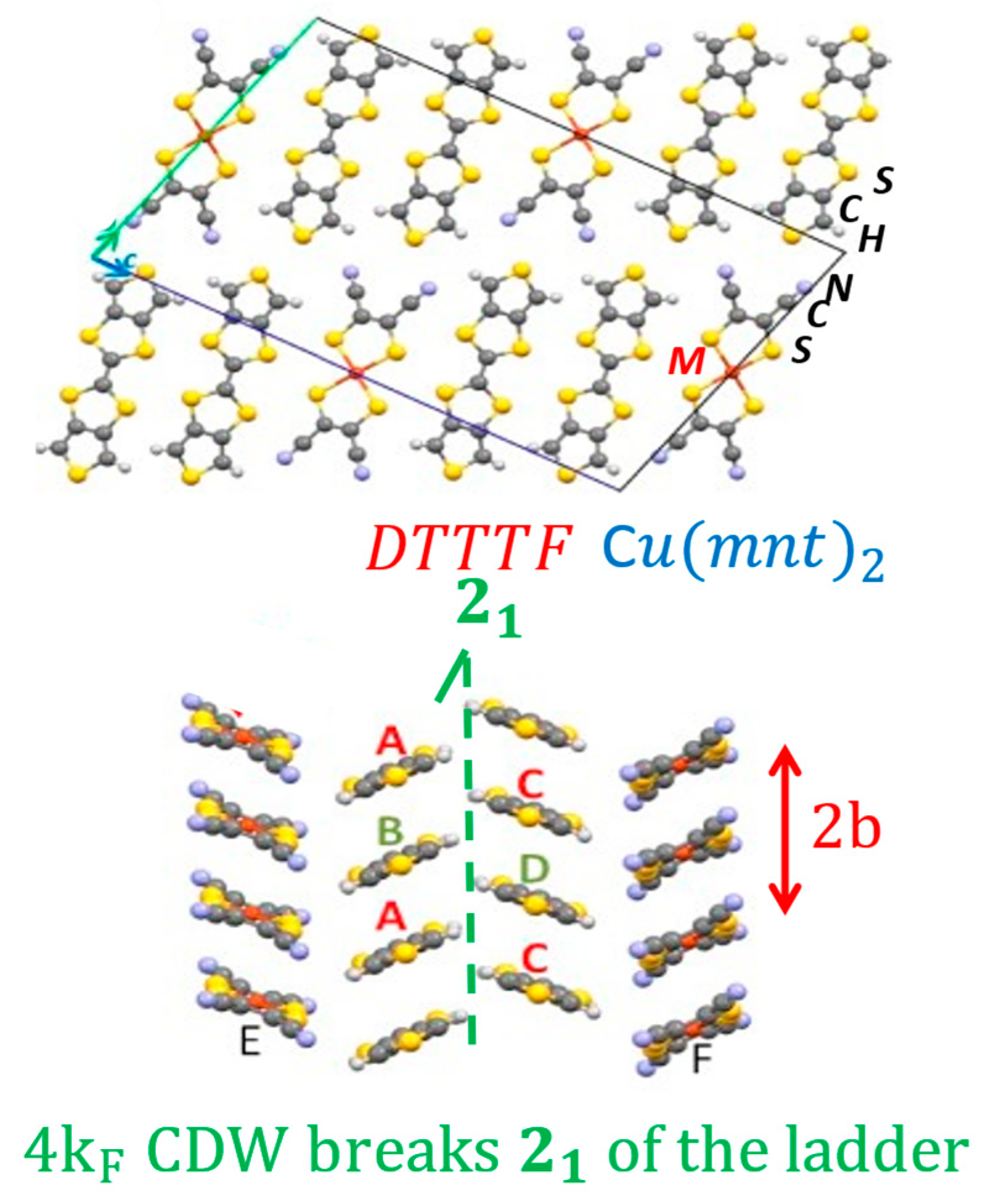
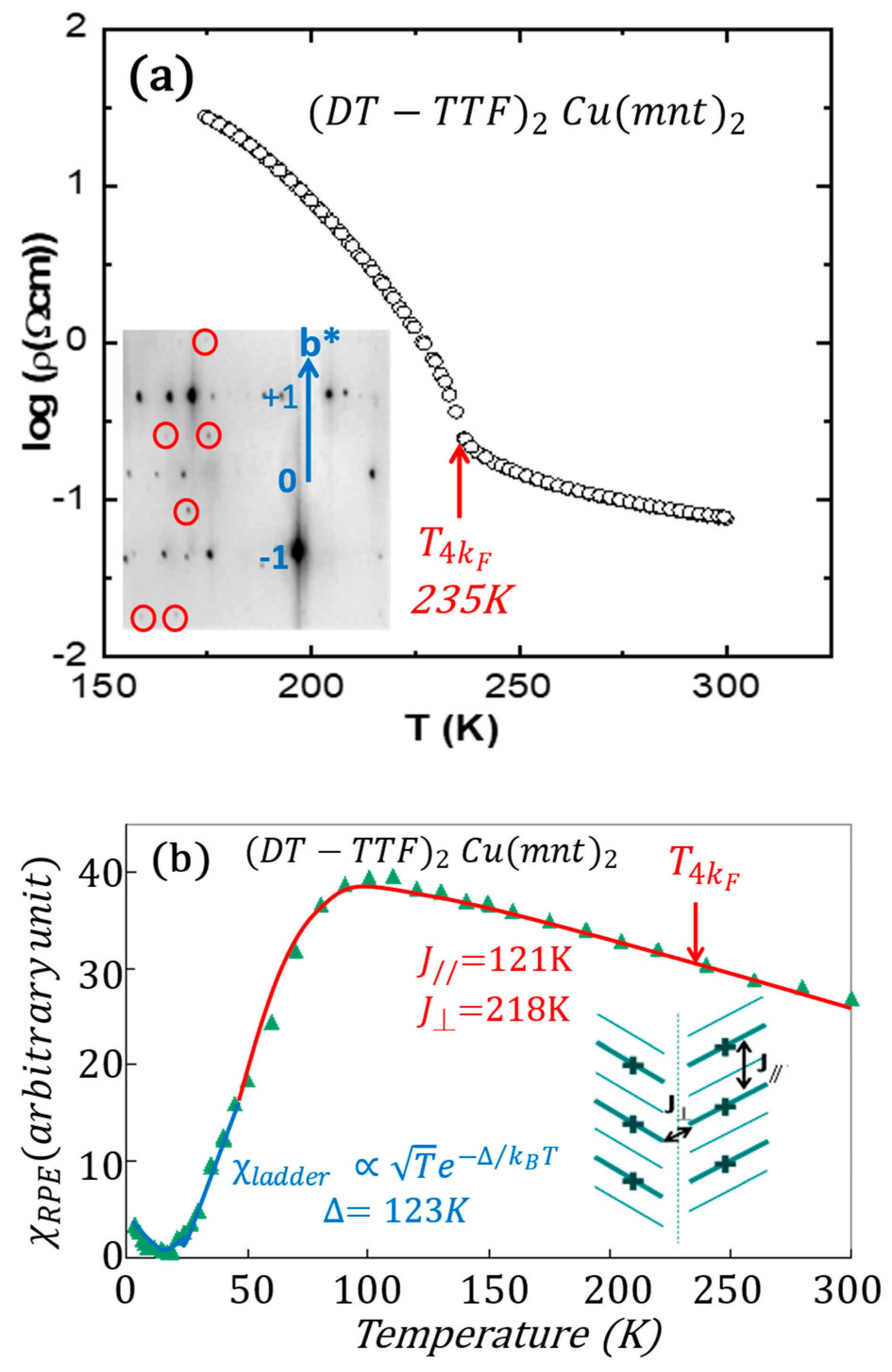
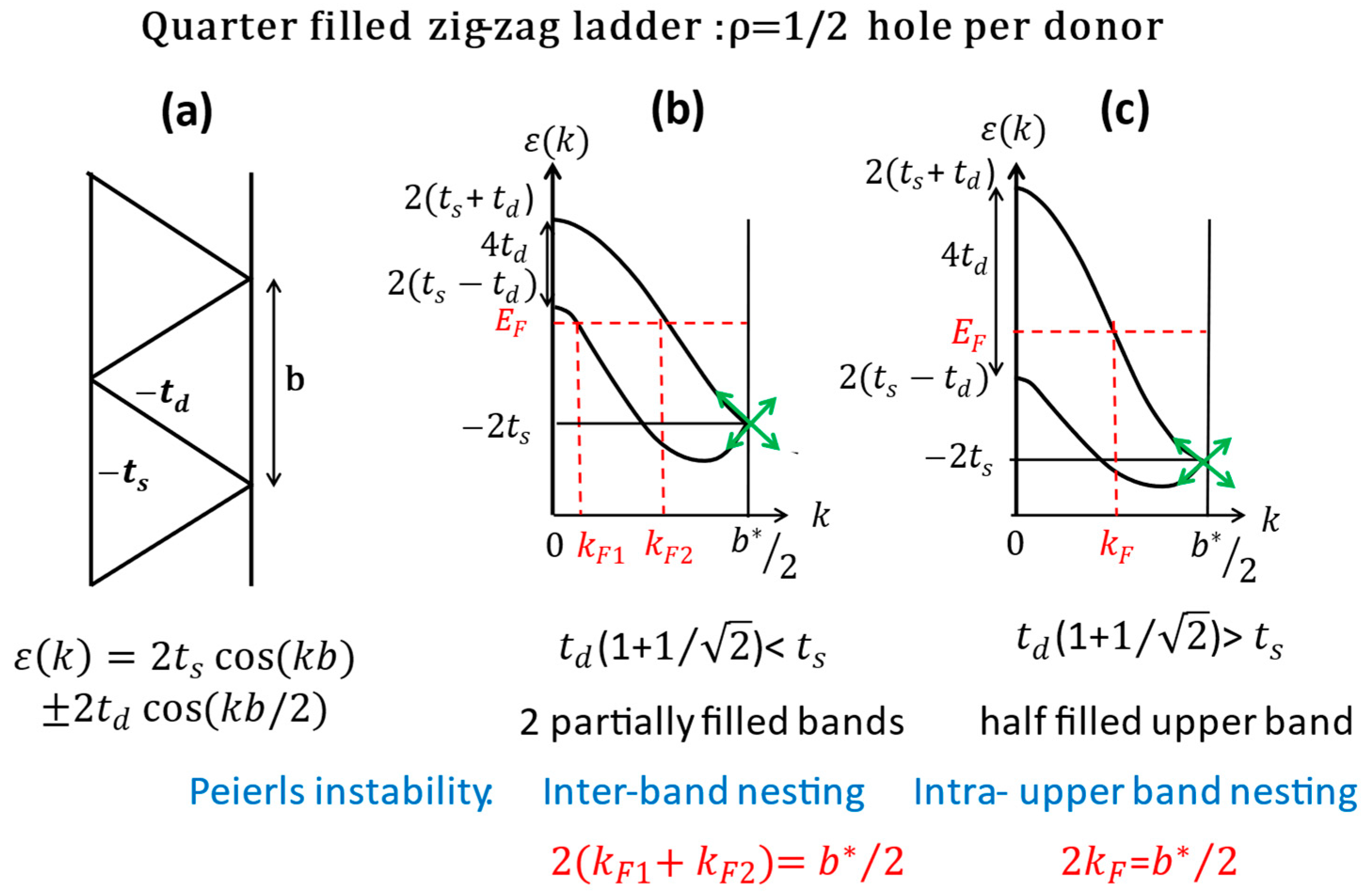


Disclaimer/Publisher’s Note: The statements, opinions and data contained in all publications are solely those of the individual author(s) and contributor(s) and not of MDPI and/or the editor(s). MDPI and/or the editor(s) disclaim responsibility for any injury to people or property resulting from any ideas, methods, instructions or products referred to in the content. |
© 2023 by the author. Licensee MDPI, Basel, Switzerland. This article is an open access article distributed under the terms and conditions of the Creative Commons Attribution (CC BY) license (https://creativecommons.org/licenses/by/4.0/).
Share and Cite
Pouget, J.-P. Spin-Peierls, Spin-Ladder and Kondo Coupling in Weakly Localized Quasi-1D Molecular Systems: An Overview. Magnetochemistry 2023, 9, 57. https://doi.org/10.3390/magnetochemistry9020057
Pouget J-P. Spin-Peierls, Spin-Ladder and Kondo Coupling in Weakly Localized Quasi-1D Molecular Systems: An Overview. Magnetochemistry. 2023; 9(2):57. https://doi.org/10.3390/magnetochemistry9020057
Chicago/Turabian StylePouget, Jean-Paul. 2023. "Spin-Peierls, Spin-Ladder and Kondo Coupling in Weakly Localized Quasi-1D Molecular Systems: An Overview" Magnetochemistry 9, no. 2: 57. https://doi.org/10.3390/magnetochemistry9020057
APA StylePouget, J.-P. (2023). Spin-Peierls, Spin-Ladder and Kondo Coupling in Weakly Localized Quasi-1D Molecular Systems: An Overview. Magnetochemistry, 9(2), 57. https://doi.org/10.3390/magnetochemistry9020057





